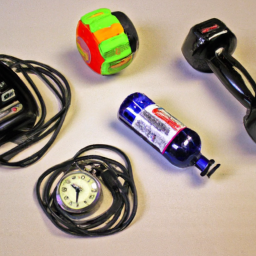In this article, you will learn about the numerous benefits of circuit training and we will provide you with a sample circuit workout routine. Circuit training is a highly efficient and effective way to get a full-body workout in a short amount of time. It combines both cardiovascular and strength exercises, maximizing your calorie burn and helping you build lean muscle. By alternating between exercises with little to no rest, you can also improve your endurance and work on improving your overall fitness level.
Now, let’s dive into a sample circuit workout routine that you can try out. Start with a warm-up of 5-10 minutes of light cardio, such as jogging or jumping jacks. Then, set up your circuit with 5-10 different exercises, targeting different muscle groups. Perform each exercise for 30 seconds to 1 minute, with 10-20 seconds of rest in between. Complete the entire circuit 2-3 times, resting for 1-2 minutes between each circuit. This circuit workout routine will not only help you burn calories and build strength, but also keep your workouts fun and exciting. Give it a try and see the benefits for yourself!
What is Circuit Training?
Definition of Circuit Training
Circuit training is a type of exercise routine that combines cardiovascular exercises, strength training, and high-intensity intervals into a single workout. It involves performing a series of exercises consecutively, with little to no rest in between each exercise. The exercises are performed in a circuit, hence the name “circuit training”. This type of training is popular among fitness enthusiasts and athletes due to its efficiency and effectiveness in improving overall fitness.
Components of Circuit Training
Circuit training typically consists of three main components: cardiovascular exercises, strength exercises, and core exercises. The cardiovascular component focuses on elevating your heart rate and improving your endurance. This can include activities such as running, cycling, or jumping rope. The strength component involves performing exercises that target different muscle groups. These exercises can include push-ups, squats, lunges, and weight lifting. Lastly, the core component focuses on strengthening the muscles in your abdomen, back, and pelvis. This can include exercises like planks, sit-ups, and Russian twists.
History of Circuit Training
Circuit training has a long and rich history, dating back to the early 1950s. The concept of circuit training was developed by R.E. Morgan and G.T. Anderson at the University of Leeds in England. They wanted to create a training program that would improve both cardiovascular fitness and muscular strength in a time-efficient manner. The original circuit training program consisted of 9-12 exercises performed for 10-15 repetitions each, with minimal rest in between. Over time, circuit training has evolved and become a popular workout choice for people of all fitness levels.
Importance of Circuit Training
Enhances Cardiovascular Fitness
One of the key benefits of circuit training is that it enhances cardiovascular fitness. The combination of cardiovascular exercises and high-intensity intervals helps to elevate your heart rate, increase lung capacity, and improve your overall cardiovascular endurance. This can have significant health benefits, such as reducing the risk of heart disease, improving blood circulation, and boosting your energy levels.
Improves Strength and Endurance
Circuit training is an effective way to improve both muscular strength and endurance. By incorporating various strength exercises into your circuit, you can target different muscle groups and promote muscle growth and development. Additionally, the high-intensity nature of circuit training helps to improve muscular endurance, allowing you to perform more repetitions and build greater stamina.
Promotes Weight Loss
If weight loss is one of your fitness goals, circuit training can be an excellent tool to help you achieve your desired results. The combination of cardiovascular exercises and strength training in circuit training creates an intense workout that burns calories and builds lean muscle mass. By increasing your metabolic rate and promoting fat loss, circuit training can be an effective method for achieving sustainable weight loss.
Saves Time
One of the biggest advantages of circuit training is its time efficiency. Traditional workouts often involve separate sessions for cardiovascular exercises and strength training, which can take up a significant amount of time. With circuit training, you can combine both components into a single workout, maximizing your time and efficiency. This makes it an ideal choice for busy individuals who want to get a complete workout in a shorter period.
Benefits of Circuit Training
Increases Metabolic Rate
Circuit training has been shown to increase your metabolic rate both during and after your workout. The combination of cardiovascular exercises and strength training raises your heart rate and activates more muscle fibers, leading to a higher calorie burn. This increased metabolic rate can help you burn more calories throughout the day, even when at rest, leading to greater fat loss and weight management.
Builds Lean Muscle
Circuit training is an effective way to build lean muscle mass. By incorporating strength exercises into your circuit, you can target different muscle groups and stimulate muscle growth. As you increase the intensity and resistance of your exercises over time, your muscles adapt and become stronger. This not only improves your physical appearance but also enhances your overall strength and functional fitness.
Improves Overall Fitness
Circuit training provides a comprehensive workout that improves both cardiovascular fitness and muscular strength. By constantly challenging your body with a variety of exercises, you can improve your endurance, strength, flexibility, and balance. This overall improvement in fitness can have a positive impact on your daily life, making everyday activities easier and reducing the risk of injury.
Offers Versatility
One of the great things about circuit training is its versatility. You can customize your circuit to suit your fitness goals and personal preferences. Whether you’re looking to build strength, lose weight, or improve endurance, you can choose exercises that target specific muscle groups and adjust the intensity and resistance to suit your fitness level. Additionally, circuit training can be done using various equipment or even just your body weight, making it accessible for everyone.
Prevents Boredom
Circuit training is a highly dynamic and engaging workout method that helps to prevent boredom. The constantly changing exercises and the fast-paced nature of circuit training keep you mentally and physically engaged throughout the workout. This can help you stay motivated and focused, making your workouts more enjoyable and effective.
Sample Circuit Workout Routine
Warm-up Exercises
Before starting your circuit, it’s essential to warm up your muscles and prepare your body for the workout. Begin with a few minutes of light cardio, such as jogging or jumping jacks, to increase your heart rate. Follow this with dynamic stretches, such as arm circles, leg swings, and torso twists, to loosen up your joints and increase flexibility.
Cardiovascular Component
The cardiovascular component of your circuit should consist of exercises that elevate your heart rate and improve your endurance. This can include activities such as jumping rope, high knees, mountain climbers, or running in place. Perform each exercise for 30-60 seconds, with minimal rest in between.
Strength Component
The strength component of your circuit should focus on targeting different muscle groups. Include exercises such as push-ups, squats, lunges, shoulder presses, bicep curls, and tricep dips. Perform each exercise for 10-15 repetitions, with minimal rest in between. You can use dumbbells, resistance bands, or bodyweight for resistance, depending on your fitness level.
Core Component
The core component of your circuit should involve exercises that engage your abdominal muscles, back muscles, and pelvis. Include exercises such as planks, Russian twists, sit-ups, bicycle crunches, and leg raises. Perform each exercise for 10-15 repetitions or hold for 30-60 seconds, with minimal rest in between.
Cool-down Exercises
After completing your circuit, it’s crucial to cool down and stretch your muscles to promote recovery and prevent injury. Perform static stretches for each major muscle group, holding each stretch for 20-30 seconds. This will help to reduce muscle soreness and improve flexibility.
Choosing Circuit Training Exercises
Consider Fitness Goals
When choosing circuit training exercises, it’s important to consider your fitness goals. If your goal is to build strength and muscle, prioritize resistance exercises such as squats, deadlifts, and bench presses. If your goal is to improve cardiovascular fitness, include activities such as running, cycling, or rowing. Tailoring your exercises to your specific goals will help you achieve the desired results.
Target Different Muscle Groups
To ensure a well-rounded workout, it’s important to include exercises that target different muscle groups. This can include exercises for your upper body, lower body, and core. By targeting multiple muscle groups, you can promote balanced muscle development and improve overall strength and stability.
Combine Cardio and Strength Exercises
To maximize the benefits of circuit training, combine cardiovascular exercises with strength exercises. This combination helps to elevate your heart rate, burn calories, build lean muscle, and improve overall fitness. Alternating between cardio and strength exercises in your circuit will keep your workout challenging and prevent muscle fatigue.
Variety and Progression
To keep your workouts engaging and prevent plateau, it’s important to incorporate variety and progression into your circuit training. This can include changing exercises, increasing intensity or resistance, or adding new challenges such as plyometric exercises or balance exercises. By constantly challenging your body in new ways, you can continue to improve and see progress in your fitness journey.
Tips for Effective Circuit Training
Proper Form and Technique
Maintaining proper form and technique is crucial for effective and safe circuit training. Performing exercises with correct form minimizes the risk of injury and ensures that you are targeting the intended muscle groups. If you’re unsure about the proper form for a specific exercise, seek guidance from a fitness professional or use online resources to learn the correct technique.
Controlled Tempo
To maximize the benefits of each exercise, focus on maintaining a controlled tempo throughout your circuit. This means performing each repetition in a slow and controlled manner, emphasizing the eccentric and concentric phases of the movement. This not only engages your muscles more effectively but also reduces the risk of injury.
Structured Rest Periods
Although circuit training is known for its minimal rest periods, it’s still important to include structured rest periods in your circuit. This will allow your muscles to recover and reduce the risk of overexertion. Depending on your fitness level and the intensity of your circuit, rest for 30-60 seconds between exercises or circuits.
Challenge Yourself
To continue seeing progress and improvements, it’s important to challenge yourself during your circuit training workouts. This can include increasing the intensity or resistance of your exercises, adding more repetitions, or reducing the rest periods. Pushing your limits and stepping out of your comfort zone will help you reach new levels of fitness.
Listen to Your Body
While it’s important to challenge yourself, it’s equally important to listen to your body and make modifications as needed. Pay attention to any pain or discomfort and adjust your exercises or resistance accordingly. It’s better to perform exercises with proper form and at a lower intensity than to risk injury by pushing yourself too hard.
Modifications for Different Fitness Levels
Beginner Circuit Training Modifications
If you’re new to circuit training or have a lower fitness level, it’s important to start slowly and gradually increase the intensity. Begin with lighter weights or just your body weight for resistance. Perform fewer repetitions and longer rest periods between exercises. As your fitness level improves, gradually increase the intensity, resistance, and overall duration of your circuit.
Intermediate Circuit Training Modifications
For those with a moderate fitness level, you can increase the intensity and resistance of your exercises. Use heavier weights or resistance bands, perform more repetitions, and reduce rest periods. You can also incorporate more challenging exercises into your circuit, such as jump squats, burpees, or pull-ups.
Advanced Circuit Training Modifications
Advanced circuit training is suitable for individuals with a high level of fitness and experience. You can increase the intensity even further by incorporating more explosive movements or incorporating advanced equipment such as kettlebells or battle ropes. You can also perform more complex exercises that require greater coordination, balance, and strength.
Common Mistakes to Avoid
Neglecting Warm-up and Cool-down
One common mistake in circuit training is neglecting the warm-up and cool-down periods. Failing to properly warm up your muscles can increase the risk of injury, while neglecting the cool-down can lead to muscle soreness and decreased flexibility. Always take the time to properly warm up and cool down to protect your body and promote recovery.
Overdoing Cardio or Strength
Another common mistake is overemphasizing either the cardio or strength component of your circuit. It’s important to strike a balance between the two to promote overall fitness. Neglecting either component can lead to imbalances in your training and hinder your progress. Aim for a well-rounded workout that includes both cardiovascular exercises and strength exercises.
Ignoring Proper Technique
Performing exercises with incorrect technique is a common mistake that can lead to injuries and reduce the effectiveness of your circuit training. It’s important to prioritize proper form and technique, even if it means performing exercises at a lower intensity or with lighter weight. Focus on mastering the correct technique before increasing the intensity or resistance.
Not Adjusting Intensity
Failing to adjust the intensity of your exercises as you progress is another common mistake. Your body adapts to the stimulus placed on it, so it’s important to continually challenge yourself by increasing the intensity or resistance. This can be done by increasing the weight, performing more repetitions, shortening rest periods, or incorporating more challenging variations of exercises.
Skipping Rest Days
Rest and recovery days are just as important as your workout days. Skipping rest days can lead to overtraining, muscle fatigue, and increased risk of injury. Make sure to include rest days in your training schedule to allow your muscles to recover and repair. Use these rest days for light activities such as stretching, yoga, or gentle walks.
Incorporating Circuit Training in Your Fitness Routine
Frequency and Duration
The frequency and duration of your circuit training workouts will depend on your fitness level, goals, and overall schedule. Beginners may start with 2-3 circuit workouts per week, while more advanced individuals can perform circuit training 4-5 times per week. Aim for a workout duration of 30-45 minutes, including warm-up and cool-down periods. As you progress, you can increase the duration or frequency of your workouts.
Balancing with Other Workouts
Circuit training can be a standalone workout or can be incorporated into a larger fitness routine that includes other types of exercise. It’s important to strike a balance between cardiovascular exercises, strength training, and flexibility exercises. This will ensure that you’re getting a well-rounded workout that targets all aspects of fitness and prevents muscular imbalances.
Tracking Progress
Tracking your progress is essential to monitor your improvements and stay motivated. Keep a workout journal or use a fitness tracking app to record the exercises, repetitions, weights, and rest periods. You can also track your cardiovascular fitness by monitoring metrics such as heart rate, distance, or time for cardiovascular exercises. Regularly review your progress and make adjustments to your routine to continue challenging yourself.
Seeking Professional Guidance
If you’re unsure about how to incorporate circuit training into your fitness routine or need guidance on proper form and technique, don’t hesitate to seek professional guidance. Consider working with a certified personal trainer who can design a customized circuit training program based on your goals, fitness level, and schedule. They can also provide valuable feedback and guidance to ensure that you’re performing exercises correctly and safely.
Conclusion
Circuit training is a highly effective and efficient workout method that offers numerous benefits for overall fitness and well-being. By combining cardiovascular exercises, strength training, and high-intensity intervals, circuit training improves cardiovascular fitness, enhances strength and endurance, promotes weight loss, and saves time. Additionally, it increases metabolic rate, builds lean muscle, improves overall fitness, offers versatility, and prevents boredom. Incorporating a sample circuit workout routine into your fitness routine can help you achieve your fitness goals and improve your overall well-being. So don’t hesitate to give circuit training a try and take your fitness journey to the next level.





